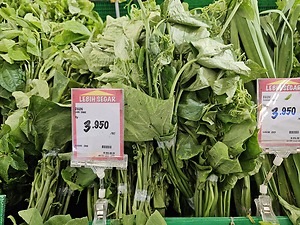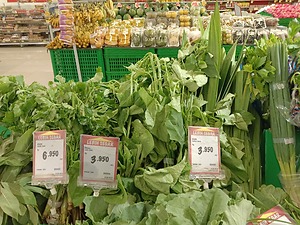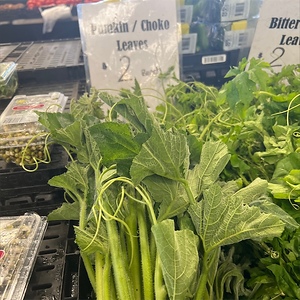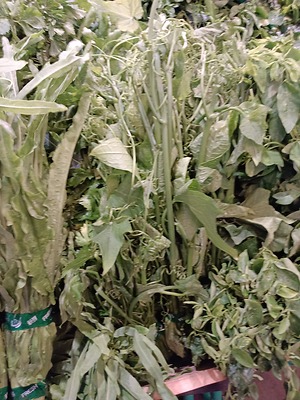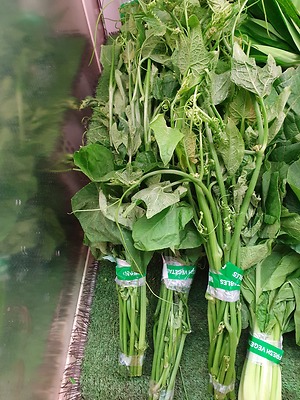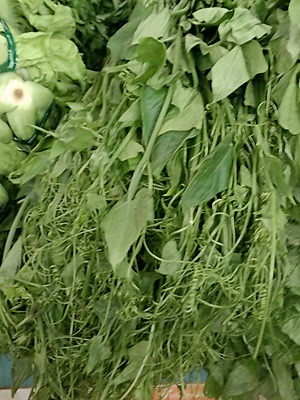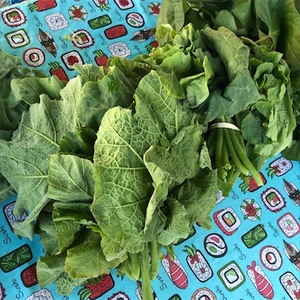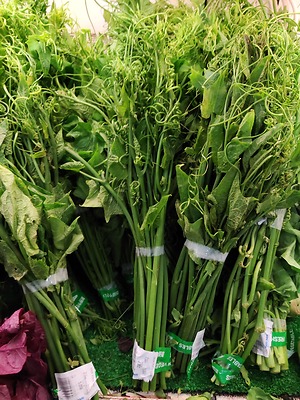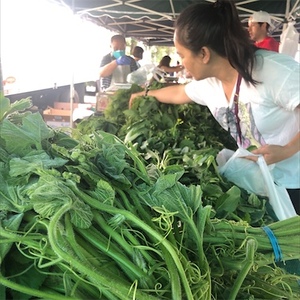


Pumpkin Leaves
Estimated Inventory, lb : 0
Description/Taste
Pumpkin leaves are large and can vary in shape and size, often featuring either a tri-lobed form or a rounded, lilypad-like, pinnate structure. These leaves measure between 18 and 25 centimeters in diameter. They grow on hollow stems with curly tendrils and often have serrated edges. Veins extend from the central line of each leaf and are more prominent on the back of the leaves. Pumpkin leaves are typically dark green, but depending on the pumpkin variety, may also be light green, gray-green, or green with white splotches scattered across the surface. They are often fuzzy with small hairs that may feel prickly in texture and grow sharper as the leaves age. Their flavor is a mix of asparagus, green beans, and broccoli. When cooked, they are soft and taste like boiled spinach and turnip greens.
Seasons/Availability
Pumpkin leaves are available year-round in warm climates and during the summer and fall in more temperate regions.
Current Facts
Pumpkin leaves are botanically classified as either Cucurbita pepo, Cucurbita maxima, or Cucurbita moschata depending on the type of pumpkin their leaves are attached to. They belong to the Cucurbitaceae family along with cucumbers, gourds, squashes, and melons. Pumpkin leaves go by many different names throughout the world including Lephotshe, Tinwembe, Mophotse, Phuri, Cetshana, Umliba, Motshatsha, Muboora, Izintanga, Mekopu, Ibobola, Pampoenblare, Thanga, or Mphodi. They grow on trailing vines and are one of the many parts of the pumpkin that are edible along with the fruit, flowers, and seeds. Pumpkin leaves are both ornamental and culinary as they are highly nutritious and used as a green vegetable in many communities worldwide.
Nutritional Value
Pumpkin leaves are a source of vitamins A, B, and C. These vitamins encourage healthy skin and vision, immune function, cell growth, metabolism, collagen production, wound healing, and iron absorption. These leaves also provide the body with phosphorus and potassium, which support energy production, muscle function, electrolyte balance, nutrient transportation, pH balance, and kidney stone prevention. They are a source of iron and calcium to help with red blood cell production, cognitive function, bone strength, muscle contractions, nerve transmission, blood clotting, and hormone secretion. Pumpkin leaves also possess beta-carotene and high phenolic levels, helping reduce oxidative stress, inflammation, and age-related macular degeneration. The fiber in these greens encourages digestion, blood sugar control, and reducing bad cholesterol levels. They have been historically valued as an herbal medicine in Africa where they are particularly sought after by pregnant women and nursing mothers.
Applications
Pumpkin leaves may be consumed raw, dried, steamed, sautéed, or cooked and are often used in place of greens like spinach. Pumpkin leaves must be peeled to remove prickly spines from the leaves and stems. Hold the leaf by its stem, cut the tip, and peel downward to strip the spines. Then, chop and cook the leaves as desired. When fresh, Pumpkin leaves are frequently tossed into salads or blended into smoothies. In Africa, they are called Ugu leaves and are used in soups like egusi, a seafood stew made with cubes of beef and shrimp that's cooked with onions, peppers, and pumpkin seeds. They are also commonly incorporated into porridge yam, a popular Ethiopian dish that combines Pumpkin leaves with palm oil, yams, chile peppers, and dried fish. In India, they are incorporated into popular saag dishes in place of spinach. Pumpkin leaves can be used on coconut-based curries or as replacements in any recipe that calls for wintergreen. Older, tougher leaves may be used as a wrap in the same way as grape leaves. Store fresh Pumpkin leaves in a plastic bag in the refrigerator, where they will be good for around three days.
Ethnic/Cultural Info
Pumpkin leaves are a highly valued leafy vegetable in many African countries, often cooked in traditional recipes. In some rural areas of Africa, they are dried to use as a vegetable during the winter when fresh produce can be hard to come by. One of the most popular Kenyan dishes featuring Pumpkin leaves is fried kahurura, where the leaves are sautéed with onions and tomatoes and often served alongside ugali, a starchy cornmeal porridge. In Tanzania, Pumpkin leaves are used alongside okra in majani ya maboga na bamia. This dish combines these ingredients with tomatoes and groundnut flour to create a thick, porridge-like consistency with a rich, nutty flavor.
Geography/History
Pumpkin leaves grow on plants native to various regions of Mexico, Central America, and South America. Along with the pumpkins themselves, these leaves prefer warm temperatures and flourish in tropical, subtropical, and temperate climates with well-drained soils. They may be found growing in wild plains, scrublands, and low-altitude deserts but are primarily sourced from home gardens and commercial farms. For up to 7,500 years, they have grown alongside pumpkins and gained popularity as a secondary crop due to their high nutritional value, often serving as a substitute for more expensive or seasonal vegetables in certain regions. Pumpkin leaves are frequently consumed in Northern, Central, and Southern Africa, particularly across all the tropical countries, where they can be found at taxi ranks, train stations, and corner markets. They are also commonly used in Korea, Mexico, and India.



